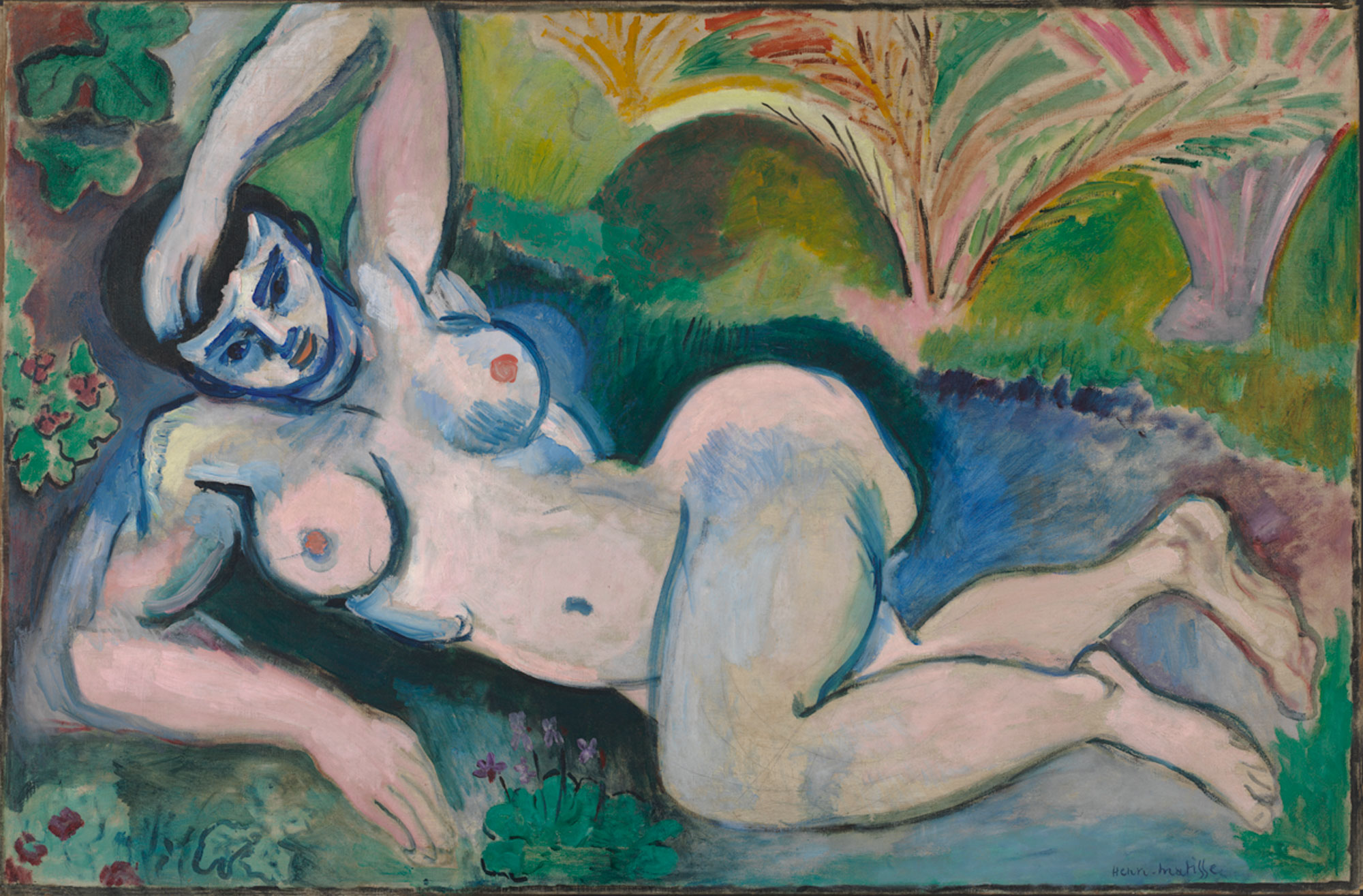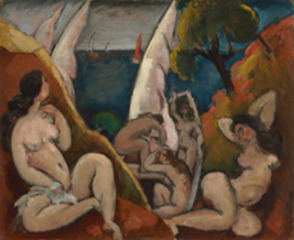The Baltimore Museum of Art organized a focus exhibition on one of the most influential American artists of the 20th century. Max Weber: Bringing Paris to New York presented nearly 40 paintings, prints, and drawings by Weber, Matisse, and other artists who influenced Weber to transform his painting style from traditional to avant-garde.
On view March 3 – June 23, 2013, the exhibition included many works loaned by the estate of Max Weber and other public and private collections as well as major works by Weber and Matisse from the BMA’s collection.
The exhibition was guest curated by Weber scholar Percy North, Professor of Art and Coordinator of Art History at Montgomery College in Rockville, Maryland, and Adjunct Professor of Liberal Studies at Georgetown University in Washington, D.C.
Weber began his three-year sojourn in Paris in 1905, and his studies with Matisse and friendships with Pablo Picasso and Henri Rousseau inspired him to develop a personal style that evoked the energy, dynamism, and technological advancements of the early 20th century. Outstanding paintings from this pivotal phase of Weber’s career include
My Studio in Paris (1907),
a glimpse of his private world in Europe and the beginning of Matisse’s influence;
The Apollo in Matisse’s Studio (1908),
demonstrating why he was one of the best students in Matisse’s class;
and Burlesque #2 (Vaudeville) (1909),
a combination of fauvist and cubist influences.
The exhibition also brought together for the first time
Matisse’s Blue Nude (1907)
and Weber’s Figure Study (1911),
a direct response to Matisse and Picasso;
and both the painting and watercolor study for Interior of the Fourth Dimension (1913), a cubo-futurist depiction of New York.
Through the artworks he brought back from Paris, Weber also became one of the first to introduce examples of Modernism in the United States. Some of the works in the exhibition by other artists from Weber’s own collection wereStill Life (1908), the first painting by Picasso to enter the U.S.;
Study for View of Malakoff, Outskirts of Paris (1908) an important painting given by Rousseau that Weber loaned to the seminal 1913 modern art exhibition at the New York Armory; and Reclining Nude (1907), a ceramic tile painted by Matisse that includes a figure reminiscent of the Blue Nude.
Additional highlights included an abstract sculpture and woodcut by Weber, and a selection of never-before exhibited drawings.
ARTIST BACKGROUND
Weber in Paris
Russian-born Max Weber had begun a career as an art teacher when his artistic aspirations led him to Paris in 1905. For three years, Weber immersed himself in the European avant-garde art world, attending exhibitions and visiting Gertrude and Leo Stein’s legendary Saturday soirées where he encountered paintings and drawings by Paul Cézanne, Matisse, and Picasso. Although he enrolled in classes at the Académie Julian, Weber sought more innovative training and became one of the founding members of Matisse’s class in 1908.
Weber in New York, Baltimore, and Beyond
Max Weber, New York at Night, 1915
When Weber returned to the United States in 1909, he was dismayed that the exciting new art he had seen in Paris was virtually unknown in America. He introduced his cubist-inspired paintings in Younger American Painters, a ground-breaking exhibition at Alfred Stieglitz’s gallery 291, and was vilified in the press. Weber began to gain acceptance a few years later when he received a solo exhibition at the Newark Museum in 1913. After a successful show at New York’s Print Gallery in 1915, Weber was invited to present the same exhibition at the Jones Galleries in Baltimore, which became his first solo exhibition outside of the New York area. A news clipping called it “the most exciting art event of the season” and said that crowds were “flocking to see it.” Feature articles appeared in the Baltimore Sun and Baltimore Evening News, and reviews were more sympathetic than those in New York. Weber’s reputation grew with subsequent exhibitions in the U.S. and Europe, and in 1930 he became the first American artist to receive a solo exhibition at the Museum of Modern Art in New York. In the 1940s, his work was introduced to households across the country through features in Life, Time, and The Saturday Evening Post.
Weber at the BMA
Weber was invited by The Baltimore Museum of Art in 1942 to be a juror for an exhibition and also received a small solo show at the museum, Paintings by Max Weber. He returned to the BMA as a juror in 1948, the same year he was selected as one of the best artists in the country by a poll of art professionals in Look magazine. On a trip to Washington D.C. in 1958, Weber visited the Cone Collection at the BMA and raved to his wife about Cézanne’s painting Mont Sainte-Victoire Seen from the Bibémus Quarry (c. 1897). His work was eventually eclipsed by the growing popularity of Abstract Expressionism, especially after the 1960 Venice Biennale organized by BMA Director Adelyn Breeskin. Weber died the following year.
From an outstanding review : (images added)
But it is really Weber’s own work that is the star of this show. The pieces in this first room primarily help prepare us for what will come. We see his transition from a diligent draftsman in an early nude drawing to a modernist in the school of Matisse. “Apollo in Matisse’s Studio” presents a statue of Apollo seen from the rear, the white marble of the god’s body alight with fauvist pinks and greens and a portrait of Matisse himself, drawn in quick, simple lines that demolish the shaded labor of the earlier drawing.
The exhibit’s second room, containing the works completed after Weber returned to New York, is the truly essential part of this exhibition, and one we are lucky to have.
Weber’s “The Bathers” from 1909 shares qualities with outdoor female nudes by Matisse, Cézanne, and Picasso, but in my opinion Weber’s women by the sea are superior to all but Cézanne’s. The flesh of the woman in the foreground is succulent—both lean and plump—and exquisitely rendered as she looks out onto the swiftly shifting sails in the sea.
“Avoirdupois,” the sole example of analytical cubism in Weber’s oeuvre, is not as great as Picasso’s and Braque’s definitive cubist works, but it is nevertheless a fascinating piece that could withstand hours of contemplation. Rendered in the beige, browns, and grays that define Picasso’s work of this period, Weber’s piece functions almost as a Monty Python-esque art machine. It’s discordant and dissolving planes overlap in space and time to create a sense of a cranking, weighing motion. The exhibit’s curator and perhaps the world’s only expert on Weber, Percy North also points out that the piece is a joke. The French word printed on the canvas, avoirdupis, refers to a scale, and in the left-hand side of the canvas, we find a bowl of what appear to be peas, pois, being weighed.
From another excellent review (images added) :
This piece alone would be worth traveling some distance to see, but “Interior of the Fourth Dimension” is the one truly monumental piece in the show. In this work—represented here both as an oil painting and a watercolor study, never before seen together—Weber combines cubist and futurist techniques to try to create a “fourth dimension” (the subject of the essay that influenced Apollinaire as well). In the center, we see a bulbous curve rendered with the Braque-like gray and beige desecration of the Impressionist daub, while on either end cool blue-gray towers of colliding spatial planes rise vertiginously toward the center.
Do yourself a favor and don’t just look at this painting head-on. Position yourself to the right of the painting so you can get it at an angle, and the space suddenly opens up and overwhelms you, revealing the painting’s subject—the dynamism of New York City.
The exhibition brings together for the first time Matisse’s notorious “Blue Nude,” 1907, which Leo Stein loaned to the Armory Show and is now in the BMA’s Cone Collection, and Weber’s “Figure Study,” 1911, a direct response to Matisse — and Picasso. A provocatively posed form similar to “Blue Nude” figures prominently in Weber’s “The Bathers,” whose brazen nudes and rugged sensuality call to mind both Matisse’s and Cezanne’s paintings on the same subject. It is a “European-inspired mélange combining the primitivizing impulse of Rousseau and Picasso with the Fauvist coloring and joie-de-vivre sensuality of Matisse,” observes North....
Weber’s still lifes demonstrate the constant invention and reinvention that was his hallmark. An early “Still Life” on view, with bananas, apples and ceramics from a titled perspective, is very much like the Picasso still life he brought back from Paris, “but Weber’s painting is richer in color and heavier in texture, creating a more tactile visual experience,” writes North in the exhibition brochure.
By 1911–1912, Weber began to incorporate Cubist devices into a number of works, although others were essentially primitive or Expressionist. Alfred Stieglitz mounted a Weber show in 1911, and Weber’s solo exhibition at the Newark Museum in 1913 was the first accorded to a Modern artist in an American museum.
For the next few years the Cubist manner predominated, but Weber also assimilated aspects of Futurism into a colorful and dynamic style best remembered today for
“Chinese Restaurant”
and “Rush Hour, New York,”
both 1915, abstract paintings that captured the kinetic energy and fast-moving life of Gotham. (The latter may have been created in response to Marcel Duchamp’s “Nude Descending a Staircase,” the sensation of the 1913 Armory Show.) As art historian Matthew Baigell has observed, “In contrast with the static nudes and amiable landscapes of his Cezannesque-Cubist work, these paintings exulted in the dynamism of modern life” in New York City.
Another notable Cubist-Futurist work, “Interior of the Fourth Dimension,” an expressively fragmented urban abstraction, suggests both the towering skyline of Manhattan and the hustle, bustle and commotion of life in the big city. Weber described the fourth dimension as “The consciousness of a great and overwhelming sense of space-magnitude in all directions at one time… It arouses imagination and stirs emotion. It is the immensity of all things.”
Catalogue

Essay by Percy North
Paperback, 36 p., 20 color illus.









